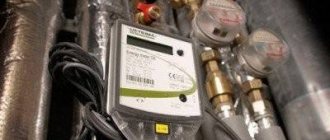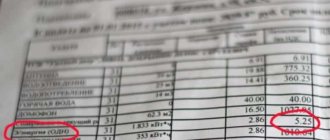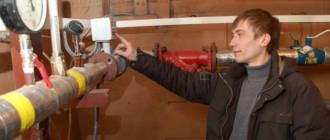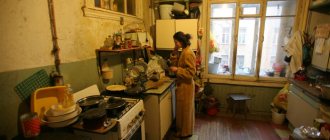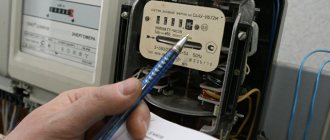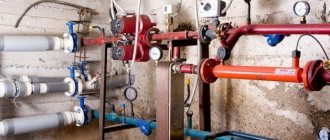The issue of paying for utility services is very acute for Russians, since their cost is often disproportionate to their earnings. Citizens try to save on everything, and one of these ways is to install an ODPU MKD (apartment building). The fact is that installing metering devices only in your apartment does not guarantee that additional amounts will not be charged in the receipt for paying for additional needs of the entire house, but a common meter will certainly reduce them. In addition, according to the government decree on charging utility bills, such devices are required to be in every apartment building. Residents who do not have a common house meter in their home must pay for the services provided at an inflated rate, determined in accordance with a coefficient of 1.6 to the standards. This is also a significant motivation to install ODPU.
What it is?
The abbreviation stands for “common house metering devices.” These devices are counters of various resources supplied immediately to the entire house, or more precisely, the entrance. The device determines the total energy consumption from all living residents and is also a distribution device.
Despite the fact that the installation of ODPU in a residential building has been mandatory by law for more than 5 years, not all citizens still have such devices in their homes.
Is it necessary to install ODPU?
Federal Law No. 261 establishes the mandatory use of such devices . Due to many residents and management companies ignoring these requirements, it was decided to punish violators with a ruble.
If the house has the technical ability to install meters, but they are missing, then increasing coefficients will be applied when calculating the amount of expenses for energy consumption. Moreover, the size of the payment increase can reach 60%.
Installation of ODPU is carried out based on the decision of the meeting of homeowners. The management company is obliged to provide explanations to residents regarding the benefits of such a decision, but it has no right to influence their will.
Those who disagree, as a rule, have a question: at whose expense are communal metering devices installed? After all, metering devices cost a lot. The financial burden falls on homeowners, but when the costs are divided among all residents, the amount becomes quite acceptable.
For example, the cost of an ODPU device for cold water consumption consists of the following expense items:
- pipeline section;
- ODPU equipment;
- technical nuances of installation;
- area of the house and number of apartments;
- volume of water consumed.
ODPU, with the exception of electricity metering devices, are installed in basements. Due to the risk of contact with water, electricity meters are installed in special switchboard rooms.
In what cases can you not install a common house meter?
You can not install ODPU only in one case, if your home does not have the technical ability to do so. Order of the Ministry of Economic Development No. 627 has clear criteria for such technical non-compliance.
In particular, these include:
- Emergency and dilapidated housing.
- Houses for demolition.
- Houses with a volume of gas used no more than 2 m3/h.
- Houses with a maximum electricity consumption of 5 kW/h.
- Houses with a consumption of no more than 0.2 Gcal/h of heat.
The Order also specifies the procedure for checking the technical equipment of the premises and the rules for filling out a special act.
Varieties
Devices for metering the consumption of common resources are usually installed in the basements or utility rooms of the building. They are produced separately for metering electricity, hot and cold water and thermal energy. After installation and startup, access to the devices from residents is blocked so that they cannot damage the equipment or change its readings.
To account for water consumption, separate devices are installed for cold and hot water. In addition to the standard meter, you can add a special sensor that determines the temperature of the supplied water and calculates its cost according to reality. That is, if insufficiently heated liquid flows through the hot water pipe, the meter will identify it as cold and charge residents a completely different payment.
Installing an ODPU for thermal energy allows you to seriously save consumed resources during the heating season.
To do this, you can use ultrasonic, tachometer, vortex or electromagnetic devices. Which ones to choose for a particular entrance are decided solely by the residents themselves.
To take into account the total energy consumption, the simplest single-tariff and multi-tariff devices are offered for installation. The latter allow you to save much more, since at different times of the day they calculate the cost of the resource at different prices. Today this is the most popular option. The essence of their work is that at night there is a minimum tariff for electricity, in the daytime it is slightly higher, and reaches its maximum during peak hours in the morning and evening. Of course, such a device will cost a pretty penny, but it will pay for itself very quickly. Installation of ODPU electricity is also carried out by a hired company of the choice of the residents themselves.
Calculation of tariffs and charging of payments
Installing a home control unit is the first step to starting to save on general housing and communal services. Please note that the total amount for the EDP is equally divided among all homeowners, taking into account the presence of individual appliances, if they are at home. To make a correct calculation, you need to know the unit price of a particular resource. The calculation is made using one of the following formulas:
- Thermal energy. The formula is for a situation where individual metering devices are not installed in every apartment, and payment for heat is made only in the winter. V x S(i)/S(o) x T. In this formula, V is the total meter readings, S(i) is the area of an individual apartment, S(o) is the total area of all apartments, T is the tariff rate.
- Thermal energy. Formula for a situation where payment for heat is made throughout the entire calendar year. V x T x S (i).
- Electricity fee. Calculated using the formula (General readings - Sum of energy use of all apartments - Sum of energy consumption in non-residential premises) X Area of the apartment of interest / Total area of the house.
- Payment for water (hot and cold). (Indications for a common house water meter - Use in common premises - Use of IPU - Consumption according to the standard) * Area of a separate apartment / Area of all apartments in the house.
Formulas for calculating the amounts payable under the ODPU and their detailed explanation are presented in the Decrees of the Government of the Russian Federation from the Decree of the Government of the Russian Federation dated 05/06/2011.
The procedure for calculating payments under the administrative budget
The procedure for calculating payment for an individual apartment occurs in three stages:
- the individual payment amount is calculated according to the readings of the individual apartment meter;
- a part of the amount is added to it according to the testimony of the general building control center;
- the amount received is included in the receipt.
If questions arise regarding the accrued amount, the responsible person is obliged to provide the resident with a report on the calculations and available readings.
Additional services
Companies that install general metering devices for homes also offer their customers additional services. In addition to subsequent maintenance of running devices, companies install additional devices that contribute to even greater savings for a fee. These include a special unit for automatically adjusting the heating system and a device that monitors electricity consumption.
All residents have the right to choose the “complete set” of their equipment themselves and can agree to auxiliary devices or purchase devices without additional adjustment elements.
What you have to pay for
The Energy Saving Law uses only the wording “metering devices”. But in reality, the cost of installation and maintenance will include:
- the cost of the hassle of collecting documents for filing an application;
- calls from specialists;
- payment for the installation project;
- installation of the meter;
- launching the PU into operation;
- scheduled verification of the device;
- inspection of filters and valves;
- replacement of components;
- repair or replacement of the device.
Device functions
The authorities require the installation of common resource meters in apartment buildings, since such devices make it possible to identify the real consumption of resources. For example, if only one citizen is registered in an apartment, then tariffs are calculated on him alone, but in fact a whole family lives in the apartment, which significantly increases the real expense.
The benefit of installing an ODPU (as described above) is also determined for residents who have individual meters for metering consumed resources in their apartments. Experts believe that individual meters are generally ineffective without installing common ones. This is justified by the fact that the presence of both individual and general metering devices helps:
- detect resource leaks in a timely manner;
- improve the payment formula;
- correctly analyze pressure, temperature and other parameters of supplied resources;
- correctly determine who exactly bears the losses in case of system violations.
In addition to this benefit for the management company, residents with individual meters in their apartments also have an advantage in installing ODPU. The fact is that their presence does not mean that the receipt will not contain a line of expenses for general house needs, which represents the expenditure of resources on servicing the elevator, playgrounds, basements and staircases. Ideally, this item should not exceed 2% of the amount of individual consumption, but in fact, all resources consumed by the entrance in excess of meter readings are taken into account here, including due to any leaks in the system.
It helps to normalize this column and correctly determine the location of the leak by installing the ODPU. What is this ability? It’s just that all leaks on the main line will no longer be included in the payment. The device records only those resources that actually entered the house. Of course, leaks may already be inside the house itself, and there are still enough reasons to raise the tariff, but the presence of such a device allows you to significantly reduce costs and is the first step towards savings.
Is it necessary to install?
Installation of communal metering devices is mandatory in Russia. Law No. 261-FZ, issued in 2009, obliges residents of an apartment building to install them in order to increase energy saving.
The rule concerns the metering of water, electricity and thermal energy.
Although the law specified the end date for installation - 06/30/2012, today many houses are not equipped with the necessary metering devices.
increasing coefficients will be used when calculating amounts payable .
These funds in the amount of 10–60% of the standards (increasing coefficients) should be directed towards the installation of metering devices.
The purpose of equipping apartment buildings with ODPU is to increase the conservation of natural resources .
So, if one person is registered in an apartment and he pays for water only for one tenant, but if six people live, there is a colossal waste of water, especially within the country as a whole.
Comparing the readings of individual (apartment) meters with those of common household meters is precisely intended to “catch” this difference, that is, to monitor the consumption of resources .
Installation approval
The decision to install ODPU thermal energy and other resources supplied to the house must be made based on the results of a vote of all residents. In this case, it is necessary to draw up minutes of the meeting. If the residents themselves do not show any initiative, the organization itself can decide on the need to install ODPU forcibly through the court, since the law obliges absolutely everyone without exception to install it.
The management company today is not obliged to notify its residents about the planned installation of devices, since this is its legal responsibility. The Criminal Code does not bear any punishment for not warning owners about this. Among its responsibilities to residents today is an annual awareness-raising of new energy-saving options to residents.
Companies that supply resources to the home can also be required to install ODPU.
The procedure for checking and replacing metering devices
Collective meters can be safely attributed to the common property of all residents of the house, therefore residents also bear collective responsibility for checking and replacing them .
But not independently, but through the management company of the house. Any company with the appropriate qualifications, the services of which the management company decides to resort to, can carry out inspections of common house metering devices.
Maintenance of metering devices at home consists of several stages:
- inspection of ODPU;
- repair in case of damage, natural wear, or failure of individual parts;
- reconciliation of readings with those that actually exist.
After the inspection, a report is drawn up . The document is signed by two parties: the management company (acting on behalf of the residents of the house) and the ODPU inspector.
The report must reflect all breakdowns, reasons for deviation from the specified parameters, and ways to eliminate them. It is necessary to indicate who exactly should correct the violations found.
Responsibility for the maintenance of the collective metering device lies with the management company. The management company “spreads” the costs of maintaining the PU among all residents of the house in terms of the monthly payment.
But, if the ODPU is equipped with an automatic reading system , the service provider company is required to pay for this. Such a system is installed by the supplier at his own expense and on his own. The residents’ task is not to interfere with the installation.
Who pays?
One of the main questions today: who should pay for the installation of ODPU? It is not controversial and has no exceptions. Federal law obliges owners to fully finance the installation of common household meters. The only step forward for homeowners is the possibility of installment payment for 5 years, that is, 60 equal payments, which will be made along with payment according to the receipt for utilities. If financially possible, owners can pay for everything at once in one payment after installing the devices or even before their installation begins.
Sometimes installation fees can be deducted from home repair and maintenance expenses, but only if they initially took into account fees for the installation of a home building in the future, which is quite rare. Additional income from the entire house can also pay for the installation if not already included in other expenses. Such income should include the amount of payment for renting out the local area or part of the building for advertising.
Who pays for installation and how?
The costs associated with these works are paid by the owners. Since the equipment is expensive, the decree provides for installment payment or leasing, which is designed for 5 years.
All costs associated with the installation of equipment, its subsequent operation, repair, and replacement are proportionally distributed among the residents of the apartment building.
There are three payment options:
- Residents pay for installation immediately.
- Payment in installments over 5 years. This amount (plus bank interest for installments) will appear on the housing and communal services receipt. The item is called “installation of ODPU”.
- Use target savings of the utility service provider allocated for energy saving and energy efficiency measures. This is the difference between the standard and the amount taking into account the increasing factor (for apartments where individual meters are not installed). Housing and communal services accountants are required to keep this money separate from general receipts. These funds can be used to install meters.
How much does installation cost?
It is equally important for owners to know who should pay more for the installation of ODPU and who should pay less. Interestingly, the number of residents registered in the apartment does not affect the cost of installation at all. Each person’s consumption is calculated based on the proportional ratio of the apartment’s area to the total area of the entire house. The calculation also takes into account the area of the total property of the house, which represents all non-residential premises of the building.
Thus, the area of a particular apartment is divided by the total area of the house, after which the result is multiplied by the area of non-residential premises of the entire building - common property in the form of staircases and so on.
The result obtained is multiplied by the cost of the device and its installation; if necessary, the amount is divided by 60 to determine the amount of monthly installment payments.
How are utility fees determined?
Calculation of payment for utility bills is formed based on the totality of all metering devices. There is a special EIR formula that varies depending on the type of resources consumed. For example, the amount of payment for water supply is calculated taking into account the following indicators: the consumed amount of resource according to the EDP indicators is divided by the amount of hot or cold water spent from an individual meter and indicators according to standards, if there are premises not equipped with a meter. The resulting number is multiplied by the tariff and again by the indicator from the individual meter.
What affects the cost?
At whose expense the installation of ODPU is carried out to a greater extent depends on the area of property in the house, and not on the number of living citizens, this is what the government decided and enshrined its decision in the Housing Code.
The cost of the entire procedure depends on the technical characteristics of the house, the availability of auxiliary devices in the selected installation configuration, as well as the type of resource taken into account. Basically the amount consists of:
- cost of the device;
- payment for its installation;
- payment for setup and launch;
- the cost of preliminary consultation and drafting;
- payment for maintenance for the next 5 years after installation.
For each house this price is determined individually.
Basic rules of use
To regulate the process of operating the ODPU and suppress possible problems with its use, there are a number of rules and laws of the Russian Federation, which include:
- If for a certain period a citizen registered at the specified address did not live in the apartment or was temporarily absent, and accordingly did not spend resources, then he has the right to recalculation. However, to do this, he will need to provide a document confirming his absence (certificate from the hospital, from work about a business trip, etc.). This document is provided to the manager or responsible person, after which a recalculation is made.
- In a situation where unregistered tenants live in the apartment, this does not exempt them from paying ODN. However, the amount is calculated either on the number of registered persons, or on the number of persons who are owners (if no one is registered on the living space).
- If monthly readings are not submitted on time, monthly average data is taken. If the readings are not transmitted within 3 months, then the amount payable is calculated according to consumption standards.
- If the property is divided in unequal shares (1/3 or 1/2, etc.), then this does not affect the accruals in any way. The amount is still calculated according to the number of owners, regardless of the shares.
- To prevent misinformation when transmitting readings over the phone, it is recommended to set a verbal password or secure identification code.
Today, ODPU is used in almost all homes. Combining common house metering devices with individual ones allows you to stabilize charges, reduce the consumption of excess resources and simplify the procedure for calculating common house needs.
How does payment work?
Receipts for utility bills arrive monthly, and the owners regularly transfer the required amounts to the accounts of the supplying companies. That is why, for the convenience of those who pay, the installation of ODPU is immediately included as a separate item in the receipt and to pay for it you do not need to go to the bank a second time a month and incur additional costs for creating another payment document.
All expenses for one-way service are calculated according to tariffs and readings of general meters, which in the very first months significantly reduces the expenses in the receipt. Over time, installing devices pays off many times over.
How to install
There is an order from the Ministry of Energy describing the procedure for installing ODPU. In accordance with it, home owners or a management organization deliver an application with a request to the RSO. The following documents certify the seriousness of the decision:
- Copies of documents confirming ownership.
- Constituent documents.
- A copy of the registration certificate from the registry authority.
- Registration document from the tax office.
- Power of attorney of the owners in the name of the person who signed the application.
After accepting these documents, the RSO has ten working days to inspect the building in the presence of a representative from the public. Then, within 15 days, the organization draws up and submits an agreement to the management organization (MA) or owners. The general meeting discusses it and no later than 15 days later returns the agreement with the signature of the responsible person to the RSO.
The nuances of paying for testimony
Some are still convinced that all remaining residents are required to pay for a persistent defaulter, since the difference between the accrued readings for individual apartments and the entire building is shared by everyone. In fact, its consumption indicators are taken into account separately according to the tariff or readings of individual meters of a particular apartment and when forming payment for the general needs of the house, it is deducted from the amount.
Commercial organizations located in a residential building also pay their expenses separately from the owners.
How are tariffs calculated for ODPU
In addition to the consumption of resources consumed directly to provide apartments and accounted for by individual meters, in any building there are places used by all residents - rooms for storing equipment, strollers, corridors, staircases and others.
We recommend: How to find out the amount of debt on a personal account or address for electricity
Household devices for monitoring the resources used make it possible to calculate the cost indicators for the maintenance of such premises and the amount of the required payment.
To calculate such costs, the following formula is used:
Rho = (P – Rind)×T,
wherein:
- Rho – the estimated amount of payment for the maintenance of public places;
- P – total flow rate determined by ODPU;
- Rind is the total consumption of energy resources based on the readings of individual metering devices;
- T – the size of the tariff for the corresponding resources.
In order to interest residents in purchasing and using ODPU, the state, in addition to tariffs, provides for the use of increasing coefficients assigned to residents of buildings that do not have communal meters installed.
Clarifications about accruals
The management company is obliged to inform its residents about the installation of ODPU - what it is, what the benefits of the devices are, and also to answer all controversial issues that arise. For example, if the amount on the receipt appears to be too high, the tenant can request a detailed explanation of the charge by filing a statement.
It should indicate the need for clarification on tariffs, calculation formulas, individual and general meter readings, the availability of connection of non-residential premises to a common meter and other features. The refusal of the Criminal Code to provide clarification is illegal.
ODPU functions
Experts are of the opinion that individual meters are not effective without OPDU. The interpretation of this statement consists of the following points.
- The ability to compare readings is necessary to monitor the operation of communication systems.
- Improving formulas for calculating payments for utility services by the population.
- Determination of leaks, analysis of resource supply parameters (temperature, pressure). OPDU allows you to determine who will bear losses in case of system violations (the management company or the installer organization).
Based on these points, it becomes clear what ODPU is in housing and communal services.
